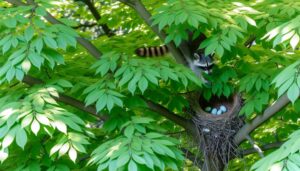Do Raccoons Eat Tomato Plants?
Yes, raccoons do eat tomato plants. As highly adaptable omnivores, they often raid gardens, especially during nighttime when their keen senses guide them to food sources.
Raccoons' opportunistic feeding behaviors make tomatoes a prime target, resulting in significant damage to the plants and fruits. Identifying raccoon tracks and understanding their activity patterns can assist in implementing effective preventative measures.
Techniques such as secure fencing, motion-activated deterrents, and natural repellents prove useful in mitigating raccoon-induced damage. For more extensive strategies and detailed guidelines on protecting your garden from these nocturnal pests, continue exploring our information.
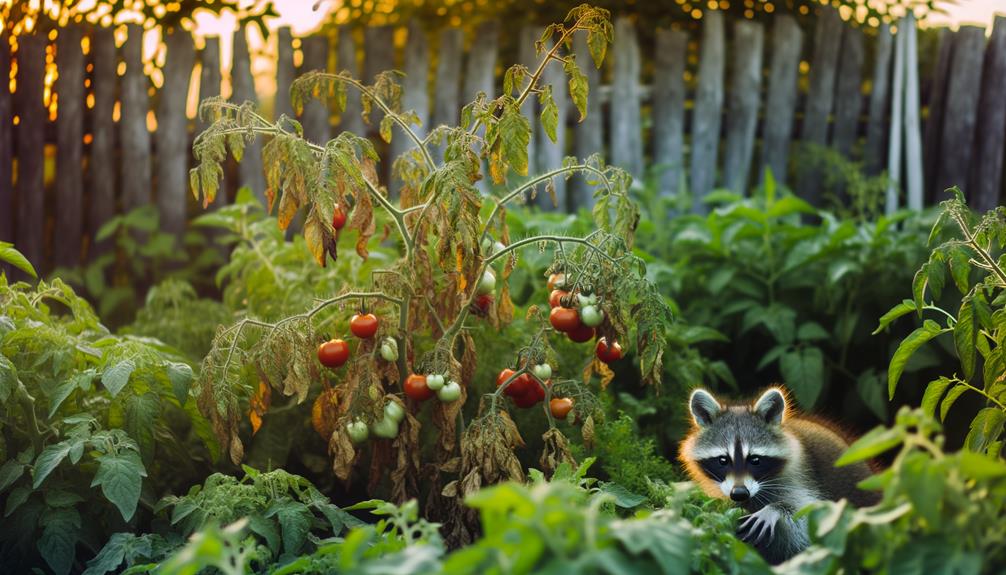
Key Takeaways
- Raccoons are omnivorous and may eat tomato plants, particularly the fruits.
- They are nocturnal and often raid gardens at night for food.
- Opportunistic feeding behaviors make tomato plants an easy target.
- Physical barriers and deterrents can help protect tomato plants from raccoons.
- Identifying raccoon tracks can provide insights into their activity in your garden.
Raccoon Eating Habits
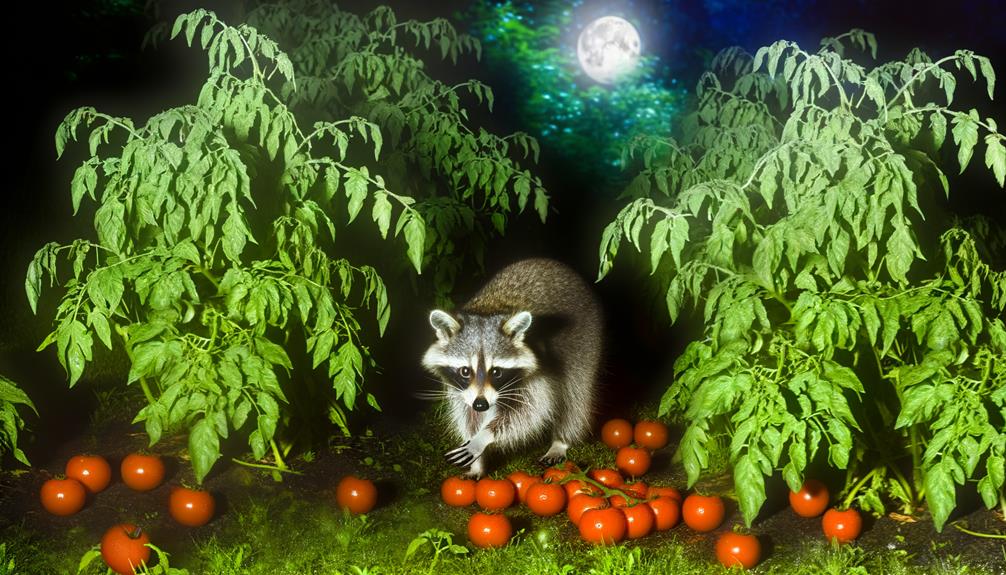
Raccoons are omnivorous creatures with a highly adaptable diet that includes a wide range of food sources, both plant and animal. Their eating habits are influenced by seasonal availability and habitat. Typically nocturnal, raccoons forage at night, exhibiting opportunistic feeding behaviors. Their diet often consists of fruits, nuts, insects, small mammals, and even human refuse.
This adaptability allows raccoons to thrive in diverse environments, from urban areas to dense forests. Anatomically, raccoons possess dexterous front paws, which enable them to manipulate and access various food items efficiently. This natural inclination toward varied food sources underscores their capability to exploit almost any available nutrient.
Understanding raccoon eating habits is essential for managing their interactions with human environments and agriculture.
Omnivorous Diet Explained
With their omnivorous diet, raccoons are capable of consuming a diverse array of food sources, which is a key factor in their adaptability and survival across various environments.
This dietary flexibility allows raccoons to thrive in both urban and rural settings. They consume fruits, vegetables, insects, small mammals, and even human refuse. Their ability to exploit a broad spectrum of food sources mitigates the impact of seasonal fluctuations in food availability.
This omnivorous nature also aids in their ecological role as both predator and scavenger, contributing to the control of pest populations and the decomposition process. The inclusion of plant matter, such as tomatoes, into their diet exemplifies their opportunistic feeding behavior, making them resilient and versatile foragers.
Nighttime Garden Visitors
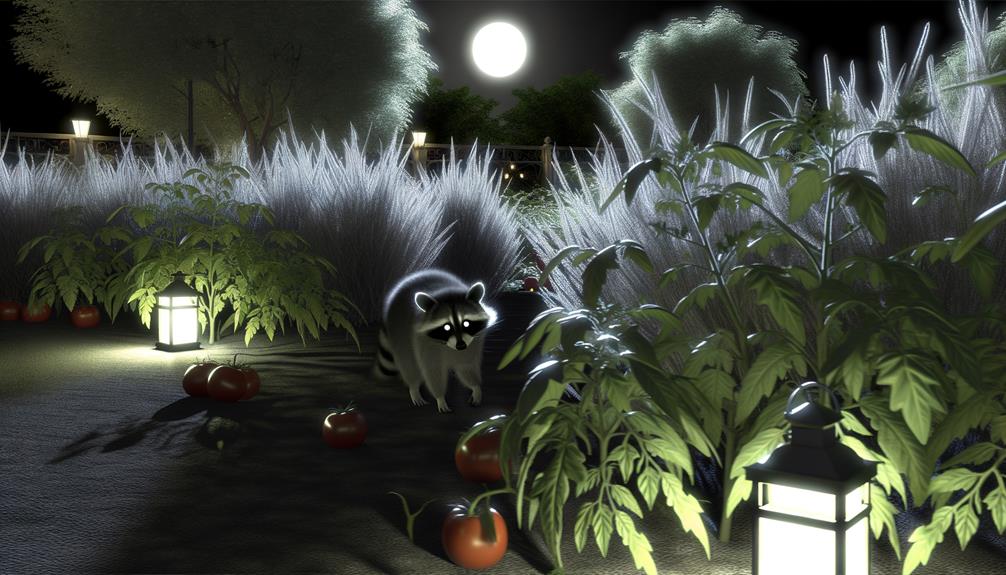
Nighttime garden visitors, such as raccoons, skunks, and opossums, can pose significant threats to tomato plants and other garden crops. These common nocturnal pests are often driven by the search for food, leading to substantial damage if not adequately managed.
Effective strategies for preventing nighttime damage include installing motion-activated lights, securing fencing, and employing natural deterrents.
Common Nocturnal Pests
Although various creatures might visit your garden during the day, nocturnal pests such as raccoons, opossums, and skunks are particularly active at night, posing significant threats to tomato plants and other vegetation.
These nocturnal animals are adept at locating food sources in the dark, utilizing their keen senses. Raccoons, for instance, are known to be intelligent and dexterous, often capable of bypassing simple barriers to reach ripe tomatoes.
Opossums primarily forage for insects but will not hesitate to consume fruits and vegetables when available. Skunks, while primarily insectivores, occasionally damage plants while searching for grubs.
Understanding the habits and preferences of these nocturnal pests is essential for gardeners aiming to protect their crops from nighttime destruction.
Preventing Nighttime Damage
To minimize the risk of nocturnal pests causing chaos on your tomato plants, implementing effective nighttime protective measures is crucial. One highly effective strategy is the use of physical barriers, such as mesh or chicken wire, to create an impenetrable enclosure around your garden. Additionally, installing motion-activated lights or sprinklers can deter raccoons and other nocturnal intruders by startling them.
Regularly inspect and maintain these barriers to ensure their integrity. Another preventive measure involves applying natural repellents like predator urine or commercially available deterrent sprays that target specific pests. Finally, securing garbage bins and removing any potential food sources from the vicinity can greatly reduce the attraction of unwanted visitors to your garden.
Tomato Plant Damage
Raccoons can cause significant damage to tomato plants by uprooting them, breaking stems, and consuming both the fruits and foliage. Their nocturnal activities often result in the complete destruction of a plant's structural integrity, as they dig around the roots searching for insects or other food sources. This uprooting can lead to water loss and eventual plant death.
Broken stems compromise the plant's ability to transport nutrients, severely affecting growth and yield. Additionally, raccoons are known to eat unripe and ripe tomatoes alike, reducing the overall harvest. Their feeding behavior can also involve tearing leaves, further impairing photosynthesis and plant health.
Such multifaceted damage underscores the need for effective protective measures against raccoon incursions in tomato gardens.
Identifying Raccoon Tracks
Identifying raccoon tracks is essential for confirming their presence around tomato plants. Raccoon tracks exhibit distinct characteristics, such as five toes and claw marks, which are typically found in soft soil or near water sources.
Analyzing common track locations within a garden can provide valuable insights into the movement patterns and potential impact of raccoons on tomato plants.
Track Shape Characteristics
The distinctive shape characteristics of raccoon tracks, including their elongated toes and claw marks, provide critical evidence for accurately identifying their presence in garden areas. Raccoon tracks typically exhibit five long, slender toes on both the fore and hind feet, often splayed outwards. Each toe ends in a pointed claw, visibly imprinting within softer substrates.
The forefoot tracks are generally smaller, measuring around 2 to 3 inches in length, while the hindfoot tracks can reach up to 4 inches. Additionally, the tracks display a unique asymmetry; the inner toes are noticeably shorter than the outer ones. These specific morphological features facilitate the differentiation of raccoon tracks from those of other mammals, aiding in the accurate assessment of their activity in vulnerable garden environments.
Common Track Locations
Frequently encountered in areas with soft, moist soil, raccoon tracks are most commonly found near water sources, garden beds, and compost piles where these nocturnal foragers search for food. These specific locations provide the best conditions for tracking due to the raccoons' need for hydration and their opportunistic feeding habits. Garden beds and compost areas, in particular, attract raccoons as they offer abundant food resources.
| Location | Soil Condition | Reason for Presence |
|---|---|---|
| Water Sources | Soft, Moist | Hydration and hunting aquatic prey |
| Garden Beds | Loose, Fertile | Foraging for vegetables and insects |
| Compost Piles | Decomposing | Access to organic food scraps |
| Forest Edges | Mixed Terrain | Shelter and diverse food availability |
Understanding these track locations aids in identifying raccoon activity efficiently.
Other Garden Pests
Gardeners often face challenges from a variety of pests that can greatly affect the health and yield of their plants. Among these, insects such as aphids, tomato hornworms, and whiteflies are particularly infamous.
Aphids feed on plant sap, weakening the plant and potentially transmitting diseases. Tomato hornworms, large green caterpillars, can defoliate plants rapidly, causing significant harm. Whiteflies, small insects that feed on the undersides of leaves, can cause chlorosis and stunt plant growth.
Additionally, rodents like voles and mice may gnaw on plant stems and roots, compromising stability and well-being. Each of these pests poses unique threats, necessitating vigilant monitoring and management to mitigate their impact on garden productivity and plant robustness.
Preventative Measures
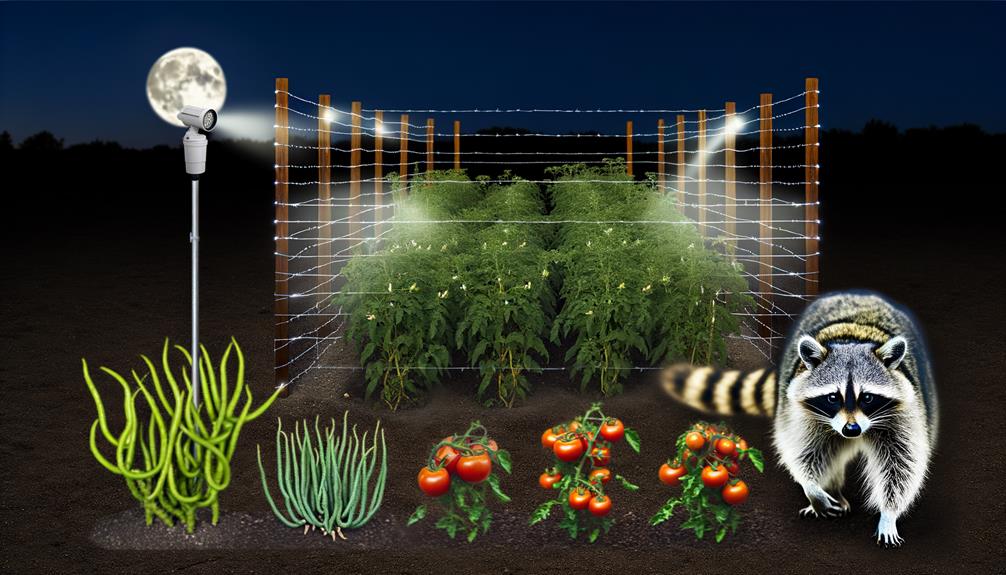
To mitigate the risk of raccoons feeding on tomato plants, implementing secure garden fencing is essential for creating physical barriers.
Additionally, motion-activated deterrents can effectively startle and discourage raccoons from entering garden spaces.
Natural repellent options, such as specific scents and substances, provide an eco-friendly approach to protect tomato plants without harming wildlife.
Secure Garden Fencing
Implementing secure garden fencing is an essential preventative measure to deter raccoons from accessing and damaging tomato plants. A robust fence should ideally be at least four feet high and constructed from materials such as hardware cloth or welded wire, which raccoons find difficult to climb or chew through.
Burying the fence at least six inches underground can prevent raccoons from digging underneath. An angled top, tilted outward, can further discourage climbing attempts. Additionally, ensuring that gate latches are raccoon-proof, such as using a combination lock or a carabiner, adds an extra layer of security.
Regular inspection and maintenance of the fence are critical to identify and repair any vulnerabilities promptly, ensuring continuous protection against these opportunistic foragers.
Motion-Activated Deterrents
Utilizing motion-triggered deterrents offers an advanced and effective strategy to safeguard tomato plants from raccoon intrusions through dynamic and responsive measures. These systems detect motion and trigger responses designed to startle or repel raccoons. Common deterrents include lights, sprinklers, and sound emitters. Analyzing their effectiveness involves understanding their operational principles and the behavioral responses of raccoons to these stimuli. Motion-triggered systems are highly adaptable and can be fine-tuned for best performance in various environmental conditions.
| Deterrent Type | Mechanism | Pros and Cons |
|---|---|---|
| Lights | Sudden illumination | Effective, but may disturb neighbors |
| Sprinklers | Water spray | Humane, but requires water access |
| Sound Emitters | Noise | Non-invasive, may need frequent adjustment |
These tools collectively offer a robust defense against raccoon damage.
Natural Repellent Options
Natural repellent options, such as specific plant choices and homemade sprays, offer an eco-friendly and sustainable approach to preventing raccoon damage to tomato plants.
Companion planting with strong-smelling herbs like mint, garlic, or lavender can deter raccoons due to their sensitive olfactory systems.
In addition, homemade sprays crafted from ingredients like hot pepper, garlic, and essential oils can be applied to plant leaves to create an unpleasant taste and smell for raccoons.
Additionally, using predator urine, such as that from foxes, can exploit raccoons' natural fear of predators.
These methods not only minimize harm to the ecosystem but also provide a cost-effective and non-toxic solution for gardeners seeking to protect their tomato plants from raccoon interference.
Fencing and Barriers
Installing sturdy fencing and barriers is vital for protecting tomato plants from raccoons, as these intelligent and dexterous animals can easily breach weak or improperly secured defenses. Effective fencing should be at least four feet high, with buried edges extending six inches underground to prevent digging.
Electrified fencing can provide an additional deterrent, as raccoons are sensitive to electric shocks. Mesh size is essential; a spacing of one inch or smaller is recommended to prevent raccoons from squeezing through.
Additionally, securing the top of the enclosure with netting or a similar barrier can deter climbing. Regular inspection and maintenance are necessary to guarantee the integrity of these defenses, as raccoons can exploit even minor vulnerabilities.
Natural Deterrents
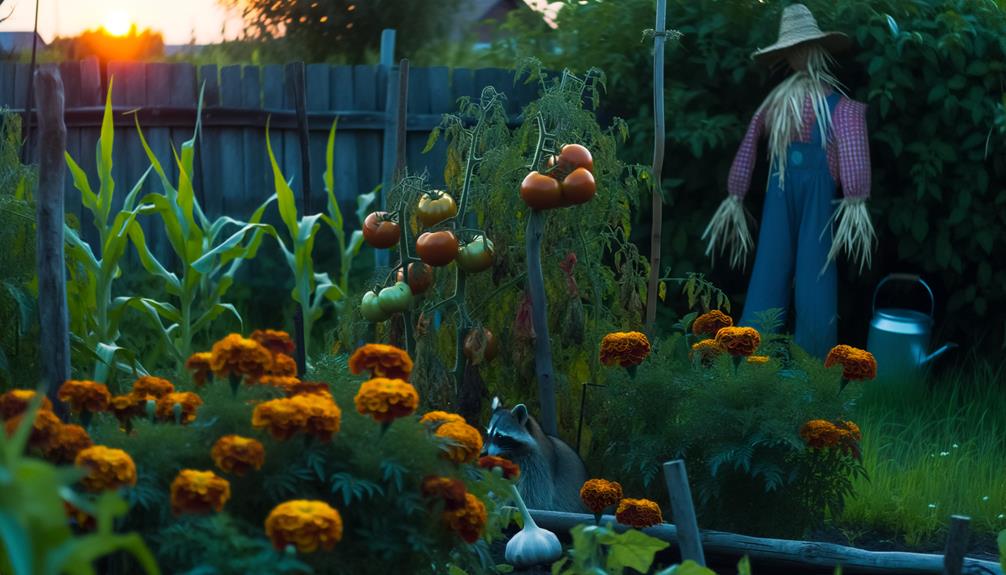
Beyond physical barriers, employing natural deterrents can be an effective strategy to safeguard tomato plants from raccoon incursions. Various odor-based repellents, such as predator urine or ammonia-soaked rags, can exploit raccoons' acute sense of smell, creating an inhospitable environment around the garden.
Moreover, planting strongly aromatic herbs like mint, garlic, or onion near tomato plants can serve as natural repellents. Motion-activated sprinklers represent another natural deterrent, utilizing sudden bursts of water to startle and dissuade raccoons from approaching.
In addition, the use of reflective objects, such as aluminum foil strips or old CDs, can create visual disturbances that deter these nocturnal animals. By integrating these methods, gardeners can effectively reduce the likelihood of raccoon-related damage to their tomato plants.
Safe Trapping Methods
Implementing humane trapping methods can provide an effective solution for managing raccoon populations without causing harm to the animals. Live traps, often constructed from sturdy metal with sensitive trigger mechanisms, are recommended for this purpose.
These traps should be baited with foods appealing to raccoons, such as marshmallows or canned fish, to guarantee successful capture. It is essential to check the traps frequently to minimize stress on the captured raccoons.
Once trapped, the animals should be relocated to a suitable habitat at least ten miles away to prevent their return. Additionally, adherence to local wildlife regulations and guidelines is necessary to ensure ethical treatment and compliance with legal standards.
This approach balances humane wildlife management with protecting valuable garden plants.
Conclusion
In sum, raccoons, with their omnivorous tendencies, pose a significant threat to tomato plants, often targeting gardens under the veil of darkness. The harm caused by these nocturnal raiders can be recognized through distinct tracks and plant devastation.
Reliable deterrents consist of robust fencing, organic repellents, and humane trapping techniques. Managing raccoon intrusions with a comprehensive strategy guarantees the safeguarding of precious horticultural assets, thus safeguarding the gardener's hard work and avoiding a repetition of the Grand Tomato Theft.

